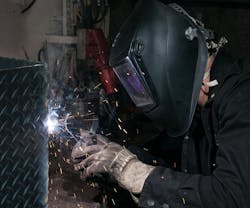OSHA New Arc-Flash Guidance is First in 20 Years
It’s been a very long time, in fact 20 years, since OHSA has updated its arc flash guidance. “OSHA’s new guidance, issued on November 25, targets two major causes of arc flash injuries and fatalities,” explained Derek Sang, senior technical training manager for Bulwark FR, in an EHS webinar. “The first is that manufacturing work as deenergized without following proper lockout/tagout procedures, leaving workers without the right PPE. And the second is believing in myth that low voltage (120/208, 277) isn’t dangerous – leading to energized work done without adequate protection or justification.”
Sang offered some analysis of the changes. He explained there are two myths:
Myth 1 De-energized Equipment Equals Safety
De-energizing equipment is only step toward achieving and Electrically Safe Working Condition (ESWC) and does not eliminate electrical hazards. Proper procedures, such as lockout/tagout and verification of de-energization must be followed.
Myth 2 Justified Energized Work is Safe
Even when work is justified (e.g. critical operations where de-energization is impractical), it is not inherently safe. Strict safety protocols, including the use of AR PPE, administration controls, and risk mitigation measures, are essential.
The other point that OSHA makes is the importance of AR PPE, says Sang. “Workers often assume they don’t need arc-rated PPE if not performing energized work. This is incorrect. PPE must be work during tasks near potential electrical hazards to mitigate risks in both energized and de-energized scenarios.“
When the update was announced The Partnership for Electrical Safety (PES) explained that over 600,000 workers did not have proper PPE or equipment to prevent injury from deadly arc-flash hazards, despite industry standards such as National Fire Protection Association (NFPA) 70E: Standard for Electrical Safety in the Workplace.
The guidance makes it clear that low voltage, including 120/208, can sustain arc flash, produce molten metal, ignite flammable clothing, and cause severe or fatal injury. All energized work over 50V requires an energized work permit and almost all work requires PPE including arc rated clothing.
OSHA also notes the significant majority of tasks which claim to be deenergized do not qualify as such. They do not meet either LOTO (OSHA) or ESWC (NFPA 70E), and thus require PPE, including arc rated clothing.
“This new guidance is a game-changer and could not have come at more appropriate time," said PES Chairman Scott Margolin in a statement. "In addition to the hundreds of thousands of electricians currently being asked to work without life-saving PPE, we’re at an inflection point.”
“Our country is investing in renewing the grid, EVs and DC chargers as the electrification of American continues," says Margolin. "OSHA recently made NFPA 70B - maintenance of electrical gear - a standard as well. This is fantastic progress, ,but will expose far more American workers - many of whom will have less training, experience, and PPE - to potential arc hazards, injuries, and fatalities. OSHA’s guidance update was imperative to clarify requirements and improve safety now.”
Employers' Responsibilities
The PES notes the following:
This guidance is not a standard or regulation, and it creates no new legal obligations. It contains recommendations as well as descriptions of mandatory safety and health standards. The recommendations are advisory in nature, informational in content, and are intended to assist employers in providing a safe and healthful workplace. The Occupational Safety and Health Act requires employers to comply with safety and health standards and regulations promulgated by OSHA or by a state with an OSHA-approved state plan. In addition, the Act’s General Duty Clause, Section 5(a)(1), requires employers to provide their employees with a workplace free from recognized hazards likely to cause death or serious physical harm.
They offer a guide for employers.
Resources for Employees
Establishing Boundaries Around Arc Flash Hazards
Being Aware of Arc Flash Hazardous
There will be a webinar from NSC to address the implications of the new guidance on Dec. 17.
See Also
About the Author
Adrienne Selko
Senior Editor
Email [email protected]
Adrienne Selko is also the senior editor at Material Handling and Logistics and is a former editor of IndustryWeek.

